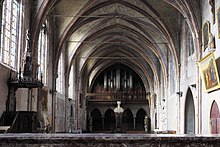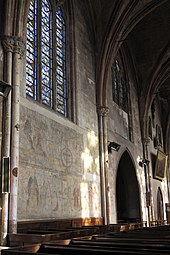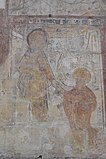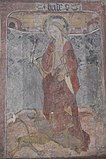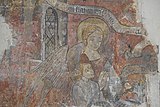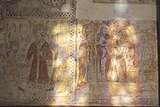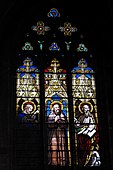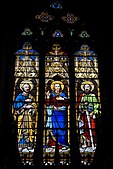St-Antoine (Bar-le-Duc)
The Catholic parish church of Saint-Antoine in Bar-le-Duc , a town in the Meuse department in Lorraine in what is now the French region of Grand Est , was built in the second half of the 14th century as a chapel for the Augustinian hermits . The church is dedicated to St. Anthony the Great . In 1989, the church, in which wall paintings from the construction period were discovered in 1912, was added to the list of architectural monuments in France as Monument historique .
history
In 1372, the Duke of Bar , Robert I , founded a monastery in Bar-le-Duc, where he settled Augustinian hermits. In the years 1372 to 1376 the church was built according to the mendicant order in simple forms. In the 15th century the ship was lengthened by three yokes . Several renovations took place in the 17th century and three chapels (Chapelle du Saint-Sacrement, Chapelle Saint-Nicolas and Chapelle Notre-Dame-de-Lorette) were added. After the monastery was closed in the wake of the French Revolution , the church suffered great damage and was used as a meeting room. In 1795 it was rededicated for worship and has served as a parish church ever since. Comprehensive renovation measures were carried out that extended over the entire 19th century.
architecture
The single nave nave is divided into nine bays. Without a transept, it joins the choir with a five-eighth end . Of the original five chapels that the church owned in the 15th century, only two have survived: the baptistery (Chapelle des fonts baptismaux) and the chapel of St. Joseph (Chapelle Saint-Joseph). They have a rectangular floor plan and are bordered by mighty buttresses. The St. Nicholas Chapel, like the Sacrament Chapel (also called Antonius Chapel), dates from the early 17th century. The latter consists of two bays and is covered by a coffered barrel vault that rests on a cornice . The Notre-Dame-de-Lorette-Chapel was built in 1640 by the architect Abraham Luguet from Nancy . The chapel has a square floor plan and is crowned by an openwork lantern .
Murals
Wall paintings from the 14th century have been preserved on the walls of the nave. On them a believer can be seen who is led by an angel. St. Ursula is shown with her attribute , an arrow that pierced her. Mary Magdalene can be recognized by her hair that envelops her body. Further scenes show a hermit, an angel and a saint with a martyr's palm who is tormented by a devil. Another scene shows a bishop blessing two saints who are going to be martyred.
Leaded glass window
The stained glass windows in the choir were made by Émile Remy in 1853. The central window with the depiction of the apostles Peter and Paul and the blessing Christ in the middle bears his signature. On the left window are the evangelists Luke and John and in the middle Antonius the Great as a monk. In the right window you can see a bishop surrounded by the evangelists Matthew and Mark .
literature
- Le Guide Bar-le-Duc . Éditions du patrimoine, Center des monuments nationaux, Paris 2013, ISBN 978-2-7577-0260-4 , pp. 84–87.
Web links
Individual evidence
- ↑ Église Saint-Antoine in the Base Mérimée of the French Ministry of Culture (French)
- ↑ Peintures monumentales in the Base Palissy of the French Ministry of Culture (French)
- ↑ Verrières à personnages (baies 0 à 2) in the Base Palissy of the French Ministry of Culture (French)
Coordinates: 48 ° 46 '22.8 " N , 5 ° 9' 34.2" E

